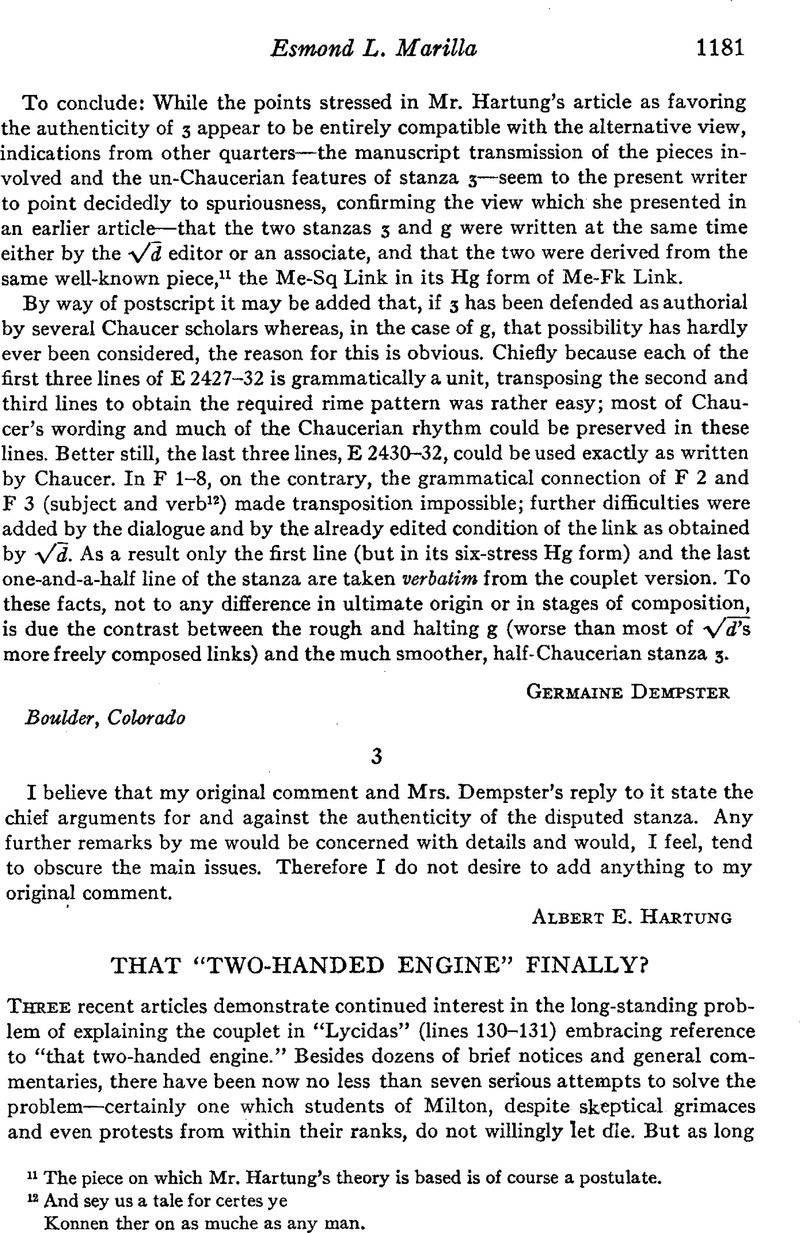No CrossRef data available.
Published online by Cambridge University Press: 02 December 2020

1 “ ‘That Two-Handed Engine’ and Savonarola,” SP, xlvii (Oct. 1950), 589-606; “Milton's Two-Handed Engine,” JEGP, xlix (Oct. 1950), 562-565; “That Two-Handed Engine,” PQ, xxix (Oct. 1950), 444-445, respectively.
2 So long as one recognizes that he is dealing with a proverbially troublesome passage in which, as LeComte acknowledges, the “language is designedly [and appropriately] ambiguous, [and the] imagery mixed,” one may focus on the argument of the one writer without implying that the views of the other two are necessarily without any justification in logic. Turner identifies the “engine” with “the lock on St. Peter's door (or the power of the lock).” He argues that the lock “could smite in the figurative sense of rendering judgment, or even literally by slamming (‘shuts amain’ or with force).” And in Turner's opinion, the lock was “two-handed” in that it had “two purposes, to admit the worthy and exclude the unworthy.” Coolidge supports previous identification of the two-handed engine with the “ ‘Sheep-hook’ named ten lines above.” He finds grounds for his position in the fact that the “staff” was regarded in the Middle Ages “as a symbol of authority analogous to the king's sceptre,” and believes that “the pastoral staff wielded as an instrument of discipline fits perfectly Milton's ecclesiastical context.” His concluding inference is that “St. Peter, speaking as a bishop of the Church, is warning his unworthy successors that ‘that two-handed engine’ which they have shown themselves incapable of holding may finally be turned to their own destruction.”
3 LeComte adds that “the wielder of the engine can only be the First or Second Person of the Trinity—which, it is perhaps not important to decide.” That there is reason, however, to believe that Milton is thinking here specifically of the Second Person will become apparent, I believe, later in the present study.
4 It is not quite clear why the author, after providing a very satisfactory interpretation of the term, feels impelled to argue that it implies “death and damnation” for the “wrongdoers.” Does not the context of the lines rather obviously impose this signification on the “engine”?
5 Since the idea of either instrument answers the demands of the context, since the term “engine” in Milton's day was applicable to almost any kind of mechanical device, and since references to God's axe and God's sword appear in the Scriptures (as well as in Milton), it may seem both unnecessary and impossible to make the fine distinction in concept here which the author undertakes.
6 The attempt here to show that Milton's lines reflect an acquaintance with Savonarola is not only unnecessary but inconsistent with the previous argument that, since Milton expected his lines to be understood by readers at the time, commentators today should bring to bear on the passage only such facts of reference as would come within the experience of readers of 1637 or 1638. That Milton knew Savonarola's works is argued on the grounds that “we are dealing with a prodigy of learning who was then in the midst of his studies of Italian history,” but on that basis can we assume that Savonarola was known to the general literary public of England in 1638?
7 The Works of John Milton, Columbia Ed. (1931), Vol. iii, pt. 1, p. 148 (my italics).